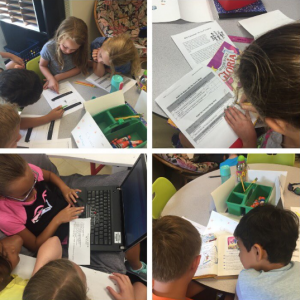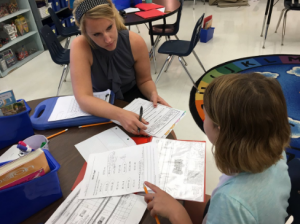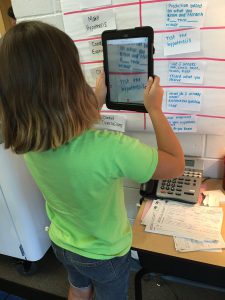Lots of classrooms today are filled with student-centered activity; it’s rare to find a teacher simply lecturing students for long periods of time. Students use technology, work in groups, sit at tables or soft-seating areas, etc. But how do you know when you’re in a Learner-Active, Technology-Infused Classroom?
 1. Students are not all engaged in the same activity. At the core of the Learner-Active, Technology-Infused Classroom is the belief that students need to be in charge of their own learning. Even the youngest students have to decide how and when they will learn. If you walk into a classroom and all students are engaged in the same activity, no matter how interesting, most likely the teacher is in charge. If you walk into a classroom where students are all engaged in different activities, some in pairs, some in groups, some with the teacher, some working individually, some on computers, and so forth . . . and the students themselves scheduled how they are using their time, odds are you might be in a Learner-Active, Technology-Infused Classroom.
1. Students are not all engaged in the same activity. At the core of the Learner-Active, Technology-Infused Classroom is the belief that students need to be in charge of their own learning. Even the youngest students have to decide how and when they will learn. If you walk into a classroom and all students are engaged in the same activity, no matter how interesting, most likely the teacher is in charge. If you walk into a classroom where students are all engaged in different activities, some in pairs, some in groups, some with the teacher, some working individually, some on computers, and so forth . . . and the students themselves scheduled how they are using their time, odds are you might be in a Learner-Active, Technology-Infused Classroom.
 2. Learning is driven by authentic, open-ended problems that students are solving. The “why?” of learning is framed with an open-ended problem to solve that was used to launch the unit of study (not used as a culminating project after the fact). Evidence of a problem alone, however, won’t do. Does the problem drive the learning by creating a “felt need” to learn? If you hear students talking about a problem, see them referring to a rubric to determine expectations, and hear them talking about how they will learn certain skills and concepts in order to solve the problem, odds are you might be in a Learner-Active, Technology-Infused Classroom.
2. Learning is driven by authentic, open-ended problems that students are solving. The “why?” of learning is framed with an open-ended problem to solve that was used to launch the unit of study (not used as a culminating project after the fact). Evidence of a problem alone, however, won’t do. Does the problem drive the learning by creating a “felt need” to learn? If you hear students talking about a problem, see them referring to a rubric to determine expectations, and hear them talking about how they will learn certain skills and concepts in order to solve the problem, odds are you might be in a Learner-Active, Technology-Infused Classroom.
 3. Teachers are facilitators of learning. Content instruction does not take place in a whole-group setting; teachers develop complex scaffolds of learning activities so that all students can learn at levels and in ways that will ensure their escalating success. Teachers are seen continually sitting with students: engaging in conversations to push student thinking, gathering formative assessment data to inform their instructional decisions, and offering small-group mini-lessons on targeted skills. If you see the teacher engaging as a powerful success-maker in the classroom through facilitation, odds are you might be in a Learner-Active, Technology-Infused Classroom.
3. Teachers are facilitators of learning. Content instruction does not take place in a whole-group setting; teachers develop complex scaffolds of learning activities so that all students can learn at levels and in ways that will ensure their escalating success. Teachers are seen continually sitting with students: engaging in conversations to push student thinking, gathering formative assessment data to inform their instructional decisions, and offering small-group mini-lessons on targeted skills. If you see the teacher engaging as a powerful success-maker in the classroom through facilitation, odds are you might be in a Learner-Active, Technology-Infused Classroom.
 4. Students are taking charge of their own learning. Students develop a schedule for the day or week that outlines the activities in which they will engage. Students negotiate time with one another for collaborative work and the use of limited resources. They use a rubric to determine the level of performance they must achieve and an activity list to access options for learning the skills and concepts they need for that level of achievement. They self-assess and share their personal progress and insights with the teacher. Through these activities and others, they are building executive function skills. If you see and hear students driving their own learning and making decisions about how they learn, odds are you might be in a Learner-Active, Technology-Infused Classroom.
4. Students are taking charge of their own learning. Students develop a schedule for the day or week that outlines the activities in which they will engage. Students negotiate time with one another for collaborative work and the use of limited resources. They use a rubric to determine the level of performance they must achieve and an activity list to access options for learning the skills and concepts they need for that level of achievement. They self-assess and share their personal progress and insights with the teacher. Through these activities and others, they are building executive function skills. If you see and hear students driving their own learning and making decisions about how they learn, odds are you might be in a Learner-Active, Technology-Infused Classroom.
 5. Technology is used by students, in ways they decide, when they need it, to enhance their learning experience. Students use computer technology on a variety of automational and transformational levels. They use computer technology to communicate and collaborate with others, including outside experts. They use it to create prototypes, model problem situations, and engage in “What if?” analysis. They use it to access information and learning activities. They use it to design and promote solutions to the problems they are solving. If you see students using computer technology in powerful ways that seamlessly fit into the learning environment, odds are you might be in a Learner-Active, Technology-Infused Classroom.
5. Technology is used by students, in ways they decide, when they need it, to enhance their learning experience. Students use computer technology on a variety of automational and transformational levels. They use computer technology to communicate and collaborate with others, including outside experts. They use it to create prototypes, model problem situations, and engage in “What if?” analysis. They use it to access information and learning activities. They use it to design and promote solutions to the problems they are solving. If you see students using computer technology in powerful ways that seamlessly fit into the learning environment, odds are you might be in a Learner-Active, Technology-Infused Classroom.
If you see all five of those key realities, odds are you are in a Learner-Active, Technology-Infused Classroom. To learn more, read Students Taking Charge, search Twitter for #LATIC, explore YouTube videos, and visit IDE Corp.
